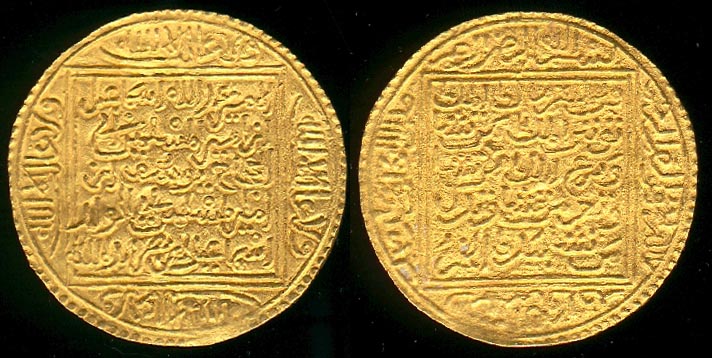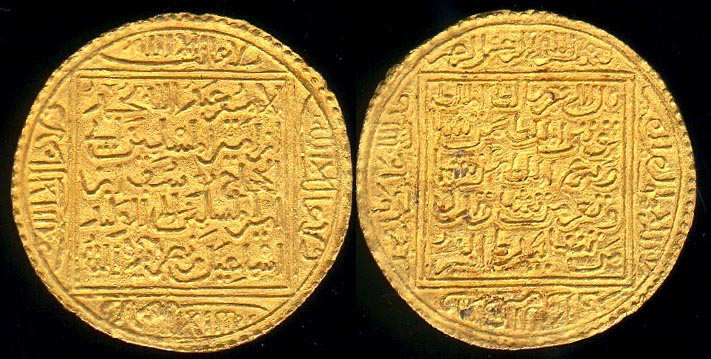|
as-Sikka
السكة |
||
| Summer 2001AD / 1422AH Vol. 3.1 | ||
|---|---|---|
A New Addition To The Numismatics Of The Emirate Of Granada.
A Dinar Of Isma'il II. 760-61/ 1358-59.
Tawfiq Ibrahim.The Emirate of Granada was to be the last Islamic state on the Iberian Peninsula. A belated expression of al-Andalus that miraculously
survived from 630/ 1237 till 890/ 1492. This long period of more than 250 years was mainly marked by an improbable, but stubborn
struggle against overwhelming odds, mainly the crushing demographic and military superiority of its Christian neighbors, Castile and
Aragon. During this borrowed time the Emirate of Granada managed to produce an exquisite and original culture whose remaining
evidences we can still admire. Not only in architecture and literary production but in its refined numismatics. For no doubt, the dinars
(doblas) of the Emirate of Granada are among the most aesthetic of medieval Islam.The turbulent dynastic history of the Emirate of Granada has left us with a list of no less than twenty three governing emirs.
Unfortunately our knowledge of their coinage has progressed with painful slowness. The cataloguing of Vives (1898), probably based
on an unpublished work of Delgado (1860´s), gave us coins for eleven of these rulers, while quite some time later Prieto (1932) was able
to add two more, and finally the late R. Lorente (1983) in a notable work on the subject adds one more, giving us a total of fourteen
rulers with known coins. Not withstanding that two of these rulers, Muhammad XI and Sa´d ibn ´Ali are represented by very dubious
dinars of base metal ( copper or very low electron. R. Lorente nº 27 & 28-29). Even accepting these last two, it has taken a full century
of numismatic studies to add three rulers to Vives´s original cataloguing. This preamble should help impress upon the reader the
relative degree of rarity of the coin here published.
IIA. IA.
Type: Dinar/ Dobla. Weight: 4.60gr. Dimensions: 32 mm.
Tonegawa Collection.
From the central legend of IIA we are told that the father of Isma´il II was Yusuf II and his grandfather was Isma´il I.[1]
In a way it is quite amazing that any coins of Isma´il II could have come down to us. For as a contemporary of the events, Ibn al-Khatib,
clearly explains in his Ihata that this ruler was an emir only in name. Having been installed on the throne of his half brother
Muhammad V in a palace coup of the 28th of Ramadan 760. A coup directed by his ambitious cousin, the future Muhammad VI, who
would at all time remain the power behind the scene. Eleven months latter, on the 26 of Sha´ban 761, the last mentioned would organize
another palace revolution ordering the assassination of Isma´il II and all the latter's immediate family. Muhammad VI ," El Bermejo"
(the red head ) of Christian chronicles, was to reign from 761-764/ 1359-1362. Ironically there are still no known coins for his reign,
though the one of Ismai´il II was surely struck by his order. Muhammad VI´s turbulent career would come to a sudden and fatal end in
Seville at the hands Pedro I of Castille, who after a generous welcome banquet would personally spear to death his honored guest. This
event would allow the deposed Muhammad V to reclaim his throne and reign, without interruption this time, till 794/1391. Ample time
for him to build, for our delight, the greater part of the Alhambra palace.
[1] It is of interest to observe that Isma´il´s coin seems to be very similar in epigraphic style, design and even in minute decorative details to a coin, probably of the
first reign, of his deposed half-brother Muhammad V (see coin below); if not the work of the same die engraver at least from the same workshop. If we take a close
look at Isma´ils coin it is easy to see that the IA was struck from a relatively worn obverse die if compared to the IIA or reverse of the same coin. This could indicate,
in view of the brevity of the reign and the rarity of the coin, that the obverse of Isma´ils coin was probably struck from a re-used die of a coin from the first reign of
Muhammad V.
Weight: 4.62gr. Dimensions: 32mm. Tonegawa Collection.References
Delgado, ( 1860´s) DELGADO Y HERNÁNDEZ, A. Estudios de numismática arábigo-española, unpublished manuscript in the Real Academia de la Historia, To be
published at end of 2001, pp about 500.
Ibn al-Khatib, LISAN AL-DIN IBN AL-KHATIB, Al-IHATA FI AKHBAR GHARNATA,
Edited by M.A.Enan, Cairo. 1973. 4 vol. For information about Isma´il II see vol I, section commencing p.398-
Prieto, (1932 ) PRIETO Y VIVES, A. Numismática granadina, Boletin de la Real Academia de la Historia, vol. I (1932), pp.305-312.
R.Lorente, (1983) RODRÍGUEZ LORENTE J.J: Numismática Nasri. Madrid (1983), pp.117.
Vives, (1893) VIVES Y ESCUDERO, A. Monedas de las dinastías arábigo-españolas, Madrid (1893). (Reed. J.Cayon, Madrid, 1978 ), pp. 553.
Unless otherwise indicated the specific electronic form of the document is copyright. Permission is granted for electronic copying, distribution in print form for educational purposes and personal use. If you do reduplicate the document, indicate the source. No permission is granted for commercial use. |
|---|

